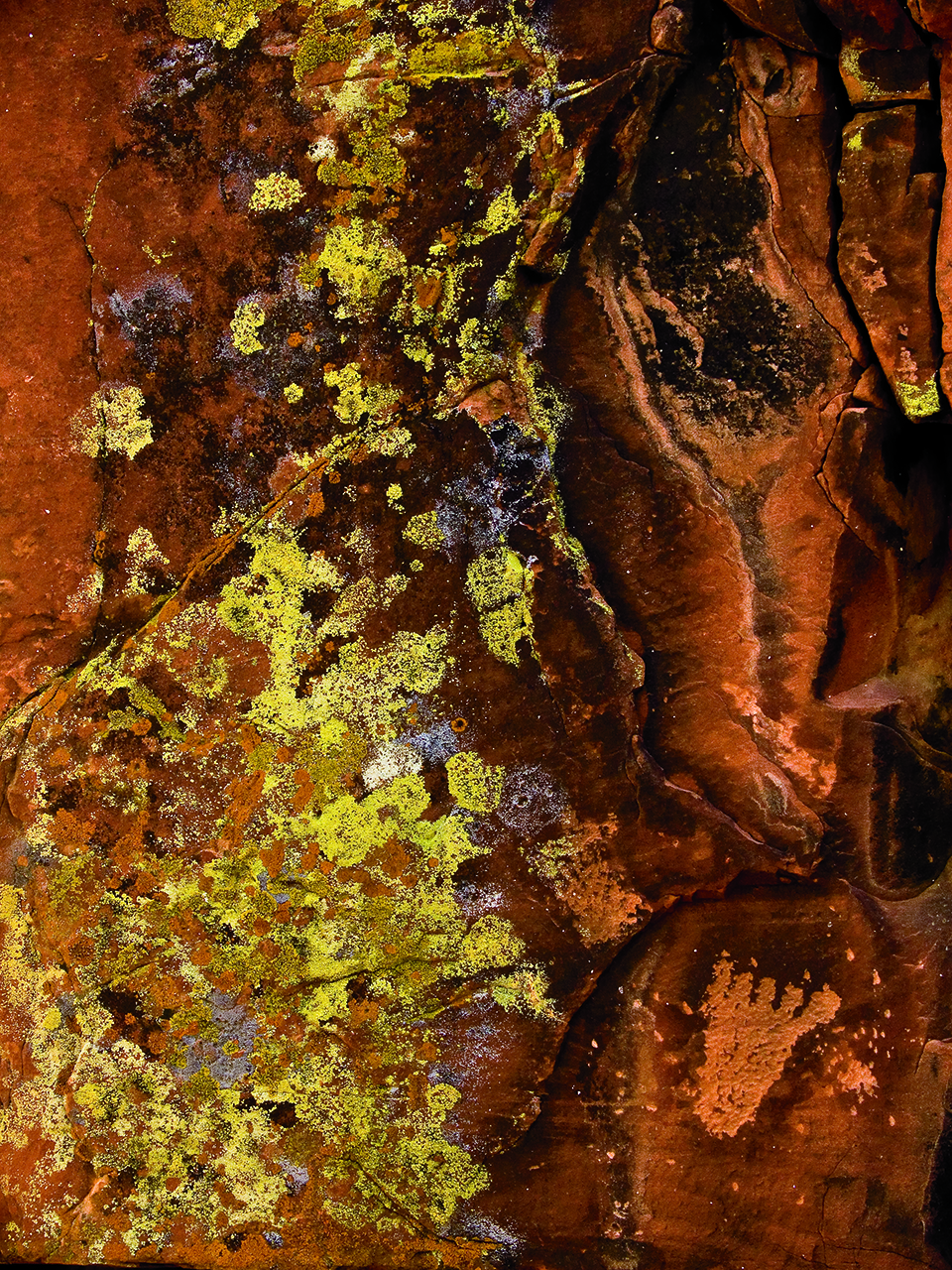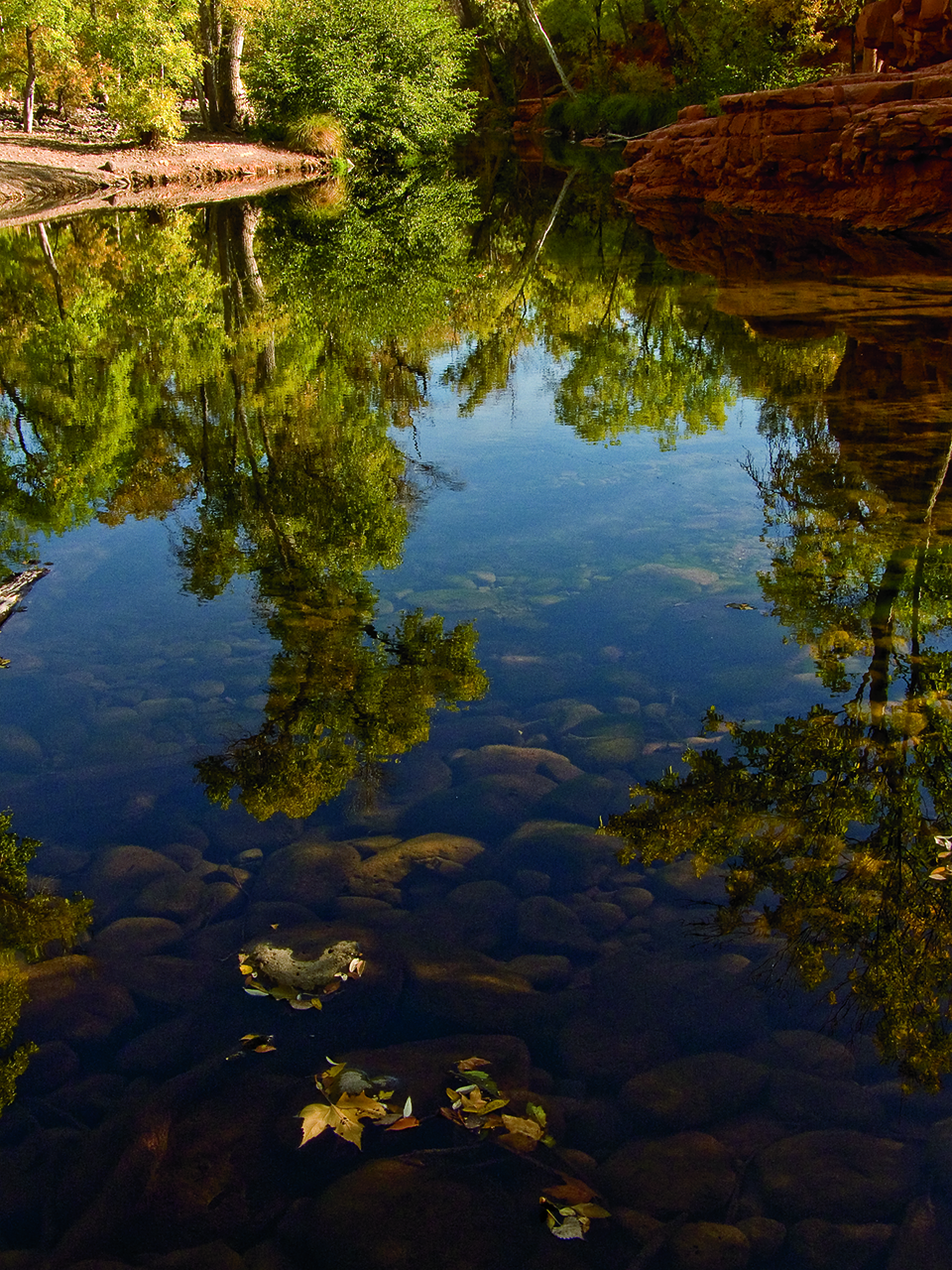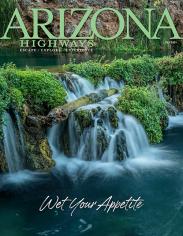A single dried blade of grass floats down Beaver Creek. Clear, mirror-still water reflects cottonwoods along the far bank, and displays moss-covered rocks on the sun-streaked creek bed. Small riffles splash upstream from the flat red rock where I sit. It is the only sound.
Photographer David Muench and I are touring the V-Bar-V Heritage Site with Forest Service archaeologist Peter Pilles. An almost pristine petroglyph site on an erstwhile ranch, the V-Bar-V is managed by Coconino National Forest, which obtained it in a 1994 land exchange. The petroglyphs, protected over centuries — first out of respect and custom, later, by private ownership of the land — remain essentially untouched. The largest known petroglyph site in the Verde Valley, the Forest Service documented it, instituted protections for it, and then opened it to the public in 1996.
As we cross an open meadow leading to the site, I imagine the invitation this fertile land, watered by perennial Beaver Creek, offered early communities. “People have been here since the beginning,” Pilles says about evidence of the Clovis culture, the earliest inhabitants of this continent.

The V-Bar-V guidebook dates the “first definitive human presence here” to the Archaic Period (1,500 to 9,000 years ago), but Pilles’ information puts people in the Verde Valley 4,500 years earlier. So, there were Clovis and Archaic hunter-gatherers, then Sinaguans, farmers, Yavapai and Apache Indians, Anglo ranchers and, finally, the Forest Service. The ranchers came in the 1860s. The Sinaguan people, credited with most of the rock art, appeared about a.d. 600 and stayed until the 15th century.
By A.D. 1300, the Beaver Creek area was a link in a series of ancient pueblos established at intervals of 1.8 miles along major waterways throughout the Verde Valley. Perfectly located to take advantage of lowland agricultural sites, upland food resources and available wild foods, each pueblo had its own identity, each traded for the goods of other pueblos. Surplus food produced by Beaver Creek settlements was a vital trade item. Archaeologists have found remains of what they traded for — ornaments of Pacific coast shell, New Mexico turquoise, red argillite from Chino Valley, pottery from the Hopi, Little Colorado River and White Mountains areas. In return, the Sinaguans provided malachite, azurite, salt and other minerals from nearby mountains, and woven cotton textiles — considered to be the finest textiles ever produced in the Southwest — made by the Sinaguans and their neighbors to the east, the Salado Indians.
Did those early people gaze into the creek as I do? What Clovis, Archaic, Sinaguan woman coming to the stream for water contemplated the mystery of reflection from this rock? Did she consider how it happens that a tree, a rock, a person is upside down? Did someone wonder how it is that what is known in one universe is presented upside down in another? Was it the creek, the life-giving water, that ordained that the spirit world be the opposite of this world? How, for instance, does the sun come to live beneath the water? If sun and water give us life, what happens when they merge — as now, this instant, in this stream?

A high fence safeguards the petroglyphs when no host is present. We enter the site and walk up sloping red earth toward the rock panel. Several large trees shade it. A rope in front of the panel keeps visitors back, protecting the petroglyphs from a human urge to touch, to take, to engage with archaeological sites in ways that can destroy them. In my more charitable moments, I name that urge to add our own mark as some ancient — if misguided — impulse to connect. In other moments, my language is less polite.
We are transfixed by the richness of the panels, a phenomenal display pecked into rock walls over centuries. There are animal tracks, stick figures, lizard-men, snakes, dog-like quadrupeds, deer, horned animals, herons, turtles, handprints, footprints and geometric forms. Symbols appear singly, in pairs, linked by meandering lines, “as if,” Pilles wrote in a 1996 paper presented to the American Rock Art Research Association, “to link them together into some story line or relationship.” All these symbols — from those who lived there, farmed there, performed shamanic rituals there, hunted in that valley, journeyed through on their way to other places — tumble across the rock like a thousand simultaneous voices in a room. Standing before them, you see symbols, but you hear voices.
“Everybody asks what rock art is about,” Pilles says. “ ‘What does it mean?’ But you’re asking the wrong question. You have to be brought up under a particular culture to know what these elements are about. If not, you can only speculate.”
Without intimacy with a culture, Pilles insists, we cannot know the mean-ing of its symbols. Because a figure looks like a deer, a sheep, a man or a giraffe does not give it literal meaning as that thing. It only says, this represents something. Sometimes a particular design appears again and again, from site to site, even continent to continent. When this happens, archaeologists know the design represents something universal, even if they do not know what.
“So the real question is, ‘What part of the culture does this pertain to?’ Everything people do could be rock-art related,” Pilles says. “The imagery of dreams is not secular, not limited by boundaries. You’ve got to forget the axiom ‘It looks like ... so it must be,’ as in, it looks like a hunting scene, so it must be a hunting scene. Instead, the killing of a deer may be a shamanic metaphor for ‘killing the rain beast’ as a prayer for rain.”
The spirit world is the exact opposite of this world, Pilles tells us, explaining that oral tradition is instructive in our understanding of shamanic tradition. Large petroglyph sites are portals to the spirit world. Cracks in the rocks are the gates, the various creatures emerging from them linked to shamanism. Some, such as insects, snakes and others, are liminal creatures that can easily slip back and forth between the spirit world and this one.

Several test pits excavated at the bottom of the panel by Arizona Archaeological Society teams trained by Pilles produced evidence of human activity as long ago as a.d. 900 and probably earlier. While the pecking style of the art on the panels has been estimated to date from the 1100s to the 1400s, this new information indicates a need for a second look at that dating. Pilles thinks it unlikely that, with so perfect a place to produce petroglyphs, no one did so until the 12th century.
“When we record petroglyph sites and say we’re finished, we know that’s not true,” Pilles says. “We know we’ll see something new the next time.”
Ripples move across the water. The light changes. Morning advances. Would a Sinaguan woman have paused to consider the shadowed places and the light? Moss and the reflection of still-green leaves glitter like emeralds, jade, malachite. There is such magic in the Earth.
Afternoon sun slides down the top of the walls. A squirrel scampers on the rocks, across boulders at the foot of the cliffs, and then crosses the red earth on which we stand and disappears into the forest. A canyon wren sings. Light washes the large panel on the left so that images dance across it. Centuries are represented on the panel. This work, created over so much time, contains time. It offers time.

